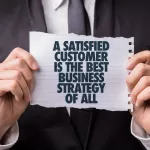No – and Here is Why.
Early in my career, I received a phone call from a recruiter asking if I wanted to interview with Toyota. It was a production line position for their Georgetown, Kentucky plant. The recruiter noted that the Toyota team asked for me specifically. Surely, it was an early-career win – Toyota, an international leader in manufacturing, was asking to interview me.
This was a once-in-a-lifetime opportunity, right?
While the job opportunity with Toyota was tempting, I turned down the offer to interview.
Could I have learned a great deal from Toyota? Absolutely.
But, I would have learned their way. And the idea of spending a couple of years learning, refining – being conditioned to do it their way – would have driven me insane.
When I went into manufacturing, I heard a great deal about Toyota. I had experiences working with TBM Consulting and Shingijutsu; and I worked and golfed with a couple of gentlemen who worked for Taiichi Ohno. I learned that all three (Toyota, TBM, and Shingijutsu) were using principles developed by others.
In other words – they were a great company, yes, but they had nothing new. They weren’t doing anything revolutionary, innovative, or curious.
That experience begets a timeless question: What makes a company great?
There are always things to learn from a great company. For all intents and purposes, they have formalized their way of doing things that works well for them. They also need a good reason to change any of that. Success can go to the head, leading some great companies to productize their solutions. Shingijutsu was created by former Toyota execs who had worked for Taiichi Ohno. Porsche Consulting leverages the quality and features of their cars into advice for others.
They also talk about that – their good, formalized way of doing things AND the fact they don’t really need to change to succeed. Unfortunately, if those who worked so hard to make the company successful are no longer around, those who have taken over don’t know what it takes. They believe that success is easy. A saying comes to mind: “they landed on second base and have no idea how they got there.”
I have often found that many great companies want to spend too much time talking about how great they are. I get it. But, it’s difficult to rely on your success and be curious at the same time. I call this the dichotomy of asking and telling; buying and selling; leading and following. Read more on the type balancing leaders need to perform: Do Businesses Need to Grow or Die?
However, the new definition for a great company needs to be a company who can do both, sometimes at the same time. It’s a type of innovative thinking.
Innovation
Innovation and innovative thinking practices have always been a part of my career. If something needed to get done, I found a way. To avoid appearing as someone who made it up as I went along, I professionalized my approach by seeking academics and experiences that would add structure – vocational automotive mechanic certification, engineering degree, an MBA, various business certifications. To keep learning, I took jobs in various industries – from automotive and military, to manufacturing and banking to name a few.
Across all those experiences, here’s what I have learned and what I offer to my clients:
- Determine the choices needed to win
- Remember your reason for being in business
- Understand what you have and what you need
- Create creativity if you don’t have it
- Stop doing activities that don’t align with your purpose
- Develop a plan to realize the future version of your company, department, job or yourself
- Then get to it
An Approach Versus a Productized Solution
As a system, I call this the DIDI approach: Discover, Integrate, Deliver, Iterate.
This system shifts how we think about great companies in these ways:
- Value: What should be at the forefront of a leader’s attention are what makes their organization unique in the way it creates, delivers, and captures value
- Environment: Leaders should be mindful of the environment they create for their people so they can be safe and productive
- Culture: Company cultures are perfectly capable of taking care of themselves – no one should directly try to change the culture and certainly should not change it for its own sake. Keep in mind though – the rule of trash in, trash out also applies to cultures not just the human mind.
- People: When leadership focuses on improving something other than people or groups of people, they allow their people to find their own way. It sends the message that the people are not the problem and can help in solving what needs to change.
- Change: People and cultures change as a result of having to adjust to a new way. That new way is based on choices made to create customers.
- Customer-Centric Design: The things to focus on are those activities that will change customers’ behaviors: your product/service, customer relationships, and the solutions to your customers’ biggest problems. It’s a moving target because customers are constantly changing their minds.
This is innovation. Today’s next generation of ‘great companies’ already have this figured out – or are working right now to figure this out.
Do I like to work with great companies? No.
I like to work with companies who want to be great.







